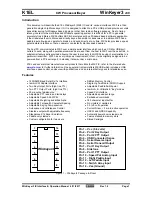
Instruction manual V 2.3
31
PWM 230 - PWM 400 - PWM 400/7.5
Instruction manual
continues modulating the rotation frequency according to the user demand, so that the
formerly halted pump now works more than the formerly working one.
Section 5.1.3.7 “CM: Role exchange policy in booster sets “ explains how to choose the way the booster and
leader roles are exchanged between the pumps.
5.1.3
Technical assistance Displays and settings (access keys MODE & SET & +)
5.1.3.1
tB: Setting of reaction time of the water lack blockage
Setting of the reaction time of the water lack blockage allows selecting the time (in seconds) taken by the
PWM system to indicate the lack of water in the electro pump. Changing this parameter may be useful if it is
known that there is a delay between the moment in which the electro pump is turned on and the moment in
which it actually starts delivering. An example could be that of a system where the suction pipe of the electro
pumps is particularly long and has some little leakages. In this case it can happen that the suction pipe
unloads when the system is in stand by, even if there is water, and that the electro pump takes some time to
reload, to deliver flow and to bring pressure to the system.
5.1.3.2
GP: Setting the proportional coefficient of the PI
Typically, the proportional term must be increased for systems characterized by elasticity (for PVC and wide
pipelines) and decreased in case of rigid installation (iron and tight pipelines).
In order to have a constant pressure in the system, PWM performs a PI control action on the measured
pressure error. The power that must be supplied to the electro pump is calculated as a function of the
mentioned error values. The control action’s behaviour depends on the values of the GP and GI parameters.
In order to adapt to behaviour of the various hydraulic system types, PWM allows selecting different
parameter values that differ from the ones set by the factory.
For most systems, the factory default values of GP and GI parameters are the optimal ones.
If there
are some regulation problems, these settings may be modified.
5.1.3.3
GI: Setting the integral coefficient of the PI
If a big pressure fall happens due to a quick increase of the flow, or to a slow response of the system, the GI
value should be increased. Vice versa, pressure oscillations around the set point value may be reduced by
decreasing the GI value.
Note:
If the PWM is far away from the electro pump hydraulic elasticity affects the PI control and,
as a consequence, pressure regulation.
This is a typical case in which a decrease of the GI value is needed.
Important:
To obtain a satisfactory pressure regulation, you usually need to adjust both GP and GI.
5.1.3.4
FS: Setting the maximum rotation frequency of the electro pump
FS sets the maximum rotation frequency of the pump; values can range between Fn - 20% and Fn + 20%
(absolute max. rating = 154 Hz). It can be useful to obtain a greater
hydraulic power (though for a limited
time) or to set an upper limit to the rotating frequency.
FS automatically aligns to Fn each time a new Fn value is set.
Overdriving of the electro pump is useful to cover high flow requests without the pressure of the system dropping below the set-point
one. This operation condition cannot last too long because the temperature increase it causes could damage the motor.
Anyway, to allow overdriving to be exploited, PWM allows to set a maximal frequency of operation higher than the rated one. Thanks to
a thermal model of the installed motor, the highest frequency supplied to the electro pump can be limited in case of excessive increase
of the temperature. The value of the highest rotation frequency (FS) can be therefore be reached only when the motor is cold and it
drops down to Fn (the rated frequency) as the windings’ temperature increases.
On the other hand, if necessary, PWM allows setting a maximum frequency of operation lower than Fn. In this case, in any condition of
regulation, the electro pump will never be driven at a frequency higher than FS.














































